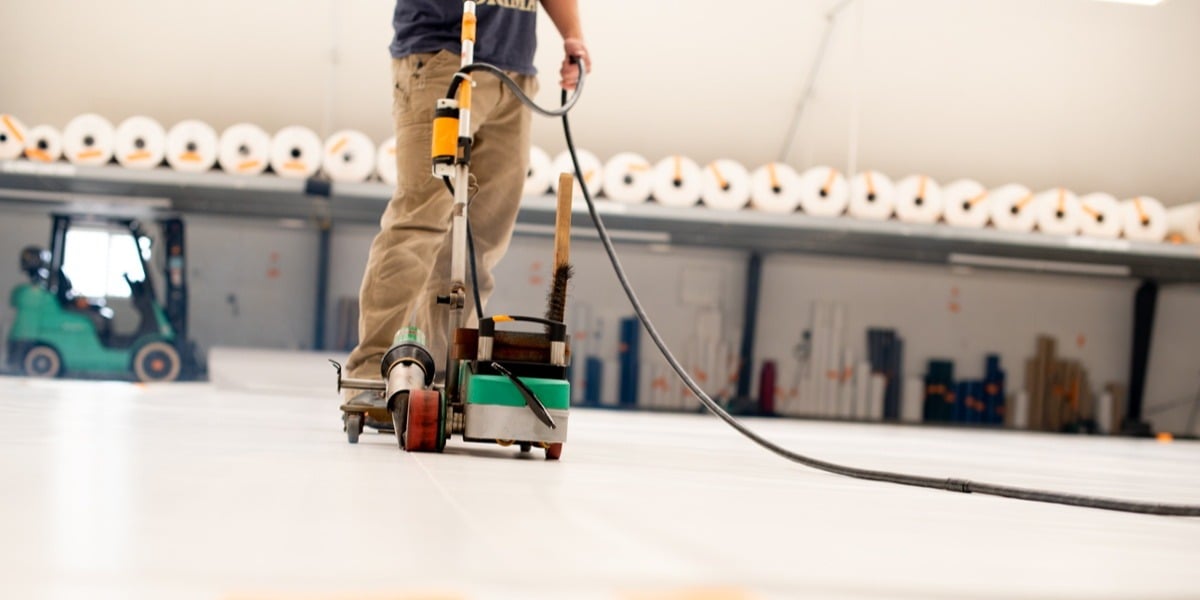Fabric Buildings vs. Steel Buildings

Fabric buildings and metal buildings have a lot in common. Legacy buildings, for example, are built with solid steel tapered I-beam frames—just like the pre-engineered metal buildings.
In general, fabric buildings with rigid I-beam steel frames are:
- Quick and easy to install
- Customizable to any size
- Sturdy and durable
- Designed with “engineering certainty.”
Once you go beyond the frames, there are important differences between steel-clad buildings and fabric structures. Some say comparing the two types of buildings is like comparing apples with oranges. Since we compete with metal buildings project after project, we prefer to think of it as comparing Honeycrisp apples to Red Delicious apples (we’re from Minnesota; we know our apples).
Durable
Building a fabric structure with a solid steel frame makes it as durable as a comparable metal building. It also opens up some opportunities to make an even better building. Legacy uses a proprietary 28 oz. PVC fabric called Exxotec™. Our fabric and our steel frames create structures that can withstand all weather conditions—snow loads, extreme wind events, and even seismic conditions.
The design of pre-engineered metal buildings is straightforward and clear. That’s why Legacy uses the same design software that is the industry standard for pre-engineered metal buildings. It’s well-understood and uses proven engineering. Our drawings are completely understandable to contractors, engineers, and construction regulators.
When it comes to time and upkeep, fabric has advantages over steel. Corrosion can take its toll on a steel building over time. In certain environments, steel frames are more vulnerable to corrosion. We can protect our steel frames with a suite of epoxy coatings—Epoxxishield™-- which create a barrier coating between the corrosive material and the steel, extending the life of your investment with longer building longevity.
With a metal building, you need to spend time and money on maintenance of the steel cladding— dealing with corrosion, leaks, etc. Fabric exteriors are completely non-corrosive. In addition, our fabric structures are virtually maintenance-free; a good rain will rinse off the entire building.
Steel buildings are also difficult and expensive to repair if damaged. Metal panels often need to be replaced as they are easily dented or punctured. Legacy’s Exxotec™ fabric is extremely durable and is not easily damaged. However, if a puncture from a forklift should occur, a repair can easily be welded onto the damaged area.
Hot and Noisy Steel
One of the first things you notice with a metal building, once it’s up, is that the echo effect can really amplify the noise inside the structure. One of the reasons sports facilities turn to our fabric structures is because they provide a quieter interior. Likewise, our equestrian customers prefer the quieter building acoustics of fabric to avoid alarming the horses.
Steel-clad buildings also are thermally conductive, meaning the temperature outside the building transfers easily to the inside of the structure. Insulation helps, but the cost of heating and cooling with all-steel walls can add up.
Legacy’s fabric has thermally non-conductive properties, so your building will be cooler in the summer and warmer in the winter.
“I love the sunlight you still get through the roof. It’s kind of like being outside all the time but still having shade. It stays pretty warm in the winter and cooler in the summer. It’s very quiet inside. When you get rain or hail or wind, there’s no banging or clanging, no sharp or rough sounds. The acoustics are good.”
- Joel Marr, Equestrian building owner
Air Tight vs. Thousands of Holes
The way cladding is attached to a structure makes a difference. The exterior steel panels are typically attached with Tek screws in a metal building. Thousands of these screws hold the panels to the frames, but over time, with building movement, those holes in the metal panels can leak water and a lot of air, especially if improperly installed. Your heating and cooling costs can be affected, and the holes can also be a place for corrosion to take hold, in addition to all the potential leaks.
With Legacy Building Solution's fabric structures, the exterior cladding is attached to the frames via a proprietary keder rail system, and that rail is attached to the frames with ½ inch bolts. The result is a very tight envelope for your building and less air leakage. Our ventilation strategies can help you control humidity inside the building, creating an ideal interior without all the anxiety of thousands of holes.
We hope this comparison clears things up for you. Many contractors and building owners automatically think of pre-engineered metal buildings when contemplating a new building. We want you to challenge this default setting and think about what you want and need. A tension fabric structure isn’t just an alternative to a steel building; it’s better.
Subscribe to our Blog
Recent Posts
- 5 Factors Every Project Owner Should Consider Before Approving Building Materials
- The 20-Year View: How Material Choices Impact Long-Term Operational Costs
- Climate Resilience in Commercial Construction: Why Traditional Methods May Not Be Enough
- Speed and Quality: The Role of Hybrid Building Materials
- Beyond the Bleachers: Designing Visually Striking Sports Facilities

